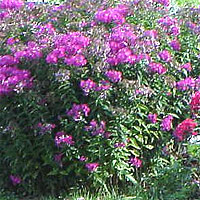Phlox

Phlox in bloom are a sight to behold, with masses of small, star-shaped, colorful flowers blanketing the plants. There are several types, the most common of which are spring-blooming creeping phlox and summer-blooming tall phlox.
About This Plant
There is a type of phlox suitable for almost any garden situation. Use spring-blooming creeping phlox as a ground cover in rock gardens and in woodland plantings. Tall garden phlox brighten the back of the border with their exuberant early summer flowers. Tall phlox are susceptible to powdery mildew, especially in regions with hot, humid summers, so choose resistant varieties.
Special Features
Easy care/low maintenance
Multiplies readily
Fragrant
Good for cut flowers
Attracts hummingbirds
Attracts butterflies
Site Selection
Select a site with moist, well-drained soil. Some types prefer full sun while other types thrive in shade.
Planting Instructions
Plant in spring, spacing plants 1 to 2 feet apart, depending on the variety. Prepare the garden bed by using a garden fork or tiller to loosen the soil to a depth of 12 to 15 inches, then mix in a 2- to 4-inch layer of compost. Dig a hole twice the diameter of the pot the plant is in. Carefully remove the plant from its container and place it in the hole so the top of the root ball is level with the soil surface. Carefully fill in around the root ball and firm the soil gently. Water thoroughly.
Care
Apply a thin layer of compost each spring, followed by a 2-inch layer of mulch to retain moisture and control weeds. Water plants during the summer if rainfall is less than 1 inch per week. As flowers fade, cut back old flower stems to encourage rebloom. Divide tall garden phlox every 2 to 3 years to promote vigor and minimize disease problems.
After the first killing frost, cut stems on tall phlox back to an inch or two above soil line.






 Phlox in bloom are a sight to behold, with masses of small, star-shaped, colorful flowers blanketing the plants. There are several types, the most common of which are spring-blooming creeping phlox and summer-blooming tall phlox.
Phlox in bloom are a sight to behold, with masses of small, star-shaped, colorful flowers blanketing the plants. There are several types, the most common of which are spring-blooming creeping phlox and summer-blooming tall phlox.